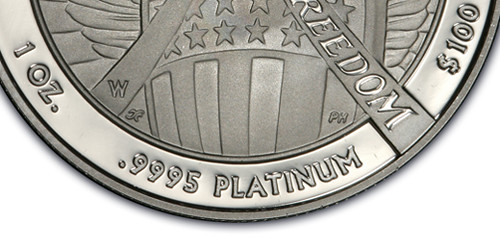
PREV ARTICLE
NEXT ARTICLE
FULL ISSUE
PREV FULL ISSUE
MORE ON COIN AND MEDAL DESIGNS WITH TWO SETS OF DESIGNER INITIALSTim L. Shuck writes: You asked in the last E-Sylum whether the 2010 cent reverse was the first time two designer's initials were included on the same side of a U.S. coin. The proof and 'regular strike' platinum eagles of the "Foundations of Democracy" series, 2006-2008, and the latest 2009 issue, all have two sets of designer initials on the reverse. The bullion issues for this period have the standard Thomas D. Rogers Sr. reverse design. The initials of sculptor/engraver John Mercanti also appear on the obverse of each year. I don't know the names of the designers for any of the proof platinum reverses, designs which have changed yearly. The image below, taken from the PCGS CoinFacts website, is of the 2007 coin, my favorite design of the type so far; two sets of initials/monograms can be seen on the edges of the shield above ".9995 PLATINUM":

Dick Johnson can usually be counted on to contribute little-known facts to the discussion, and this is no exception. Below is his commentary on both coins and medals designs with more than one set of designer initials per side. One medal sports the marls of FIVE contributors. Can anyone top THAT? Thanks, Dick.
-Editor
On observing the dual initials on the reverse of the 2010 cent editor Wayne Homren asked last week if there had been a previous instance where two artist's initials had appeared on one side of an American coin. The answer: Yes, numerous times. Perhaps too numerous to mention. But one instance which should be mentioned is the Oregon Trail Commemorative Half Dollar of 1926 (Breen 7468-7481). It was created by two medallic artists, James Earle Fraser and his wife Laura Gardin Fraser. They combined their initials with a single large F at the right, a small JE over a small LG, so it would read JEF and LGF. Now that's charming! In another instance in the commemorative half dollar series, the husband and wife team of William Marks Simpson and Marjorie Marks Simpson signed WM + MES on the Norfolk Virginia Tercentennial Half Dollar (Breen 7561). Just letters, no attempt at charm. But what is really interesting is the subject of signatures on medals. Two artists prepared the medal for an art organization they were both members: The Society of Illustrators Medal of 1950 (Medallic Art Company 50-35). They combined their last name initials C and F into a monogram with the F partially inside the C and the middle arm of the F forming part of the C. The artists: Mario Cooper and Robert Foster. C and F. The Danish Washington Medal of 1876 (Baker 426) has three signatures: I Christensen, H. Orlik and F. Schmahlfield. The Columbus Milan Medal of 1892 (Eglit 106) was struck by Stefano Johnson (no relation to me -- I wish he was!). Since this was one of their first medals reduced from oversize models and reduced on a die-engraving pantograph, they included the initials of the operator of the reducing machine -- in addition to the signatures of the two Italian artists that prepared the design and made the models! That is significant! But a United States Mint medal holds somewhat of a world's record - five signatures on one medal! The Duncan Ingram Congressional Medallion of 1855 (Julian NA-26) was struck by the Philadelphia Mint. The five artists are: S. Eastman D, P.F. Cross SC, James B. Longacre -- those signatures appear on the obverse. S. Eastman D and J.B. Longacre SC appear on the reverse. The D is for designer, the SC means sculptor. Interesting that Longacre calls himself a sculptor on the reverse. With that many signatures we need to identify who did what -- the division of labor. Seth Eastman designed both sides. He gets a "D" on both sides. Peter F. Cross modeled -- or engraved -- the obverse scene. He gets an "SC." He could have modeled the design in clay or plaster, or engraved a die direct. He probably modeled the design oversize and furnish this model to James Barton Longacre, who at the time was chief engraver at the U.S. Mint at Philadelphia. Longacre probably cast Cross's model making a metal galvano pattern, then using that on the Mint's Hill reducer made a reduction punch. He sunk that punch into a blank die, then added lettering afterwards with letter punches. For the reverse Longacre did all the engraving -- eagle, rays and wreath -- and hand punched all the lettering. Longacre signed both sides, adding Seth Eastman's name on both sides for the design, and credited Peter Cross for his contribution of the obverse. Whew!
To read the earlier E-Sylum article, see:
THE 2010 LINCOLN CENT SHIELD REVERSE DESIGN
(www.coinbooks.org/esylum_v13n08a20.html)
The Numismatic Bibliomania Society is a non-profit organization promoting numismatic literature. See our web site at coinbooks.org. To submit items for publication in The E-Sylum, write to the Editor at this address: whomren@gmail.com To subscribe go to: https://my.binhost.com/lists/listinfo/esylum All Rights Reserved. NBS Home Page Contact the NBS webmaster 
|